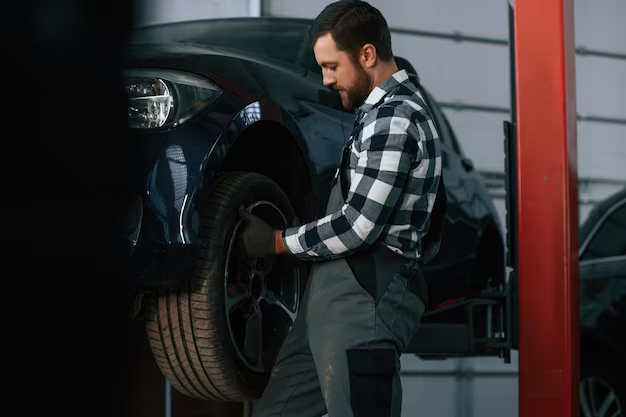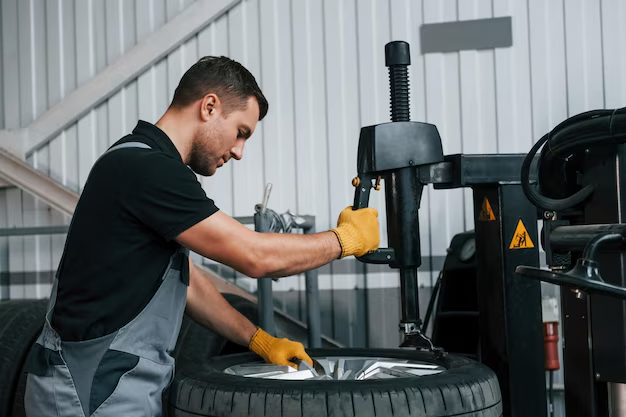Tires are the unsung heroes of our vehicles, tirelessly supporting us through every mile, yet often overlooked until something goes wrong. For local drivers here in San Leandro, CA, keeping tires in top condition isn’t just about extending their lifespan—it’s also about ensuring safety and improving fuel efficiency. In this guide, we’ll explore ten straightforward maintenance tips that will keep your tires rolling smoothly for longer. By the end, you’ll be equipped with the knowledge to maintain your tires like a pro and avoid unnecessary trips to the repair shop.
Check Tire Pressure Regularly
Maintaining the correct tire pressure is crucial for tire longevity and vehicle safety. Underinflated tires can lead to increased wear and decreased fuel efficiency, while overinflated tires may cause a harsh ride and increase the risk of a blowout. Imagine a balloon that’s blown up too much—it feels stiff and ready to pop. Similarly, overinflated tires are more susceptible to damage from road hazards.
How to Check Tire Pressure
Use a reliable tire pressure gauge to measure the pressure in each tire. Most vehicles have a recommended tire pressure listed in the owner’s manual or on a sticker inside the driver’s door. Checking your tire pressure monthly is a good habit, especially before long trips. Regular checks can prevent uneven wear, which might otherwise lead to costly replacements—typically ranging from $100 to $300 per tire depending on the brand and model.
Seasonal Considerations
In San Leandro, the mild climate means we don’t experience extreme temperature swings. However, minor changes in temperature can still affect tire pressure. As a rule of thumb, check your tire pressure more frequently during the transition between seasons to ensure optimal performance. Picture a rubber band that tightens and loosens with temperature changes—tires behave similarly, affecting their performance and longevity.
Rotate Your Tires
Regular tire rotation helps ensure even wear across all tires, which can extend their lifespan and improve performance. Consider it like rotating your favorite shoes to ensure both pairs wear evenly.
When to Rotate
Experts recommend rotating your tires every 5,000 to 8,000 miles. This interval often coincides with routine oil changes, making it easy to remember. If you think of your tires like a pair of running shoes, rotating them regularly ensures that no single shoe—or tire—wears out prematurely.
Rotation Patterns
There are different rotation patterns depending on whether your vehicle is front-wheel, rear-wheel, or all-wheel drive. Consult your vehicle’s manual or a professional at JC Auto Repair for the best rotation pattern for your car. This simple maintenance task, typically costing around $25 to $50, can prevent uneven wear and save you money in the long run by delaying the need to purchase new tires.
Align and Balance
Proper alignment and balance are key to preventing uneven tire wear and ensuring a smooth ride. Misalignment can cause your vehicle to pull to one side and lead to rapid tire wear. Think of alignment like the rudder on a boat—if it’s not straight, your journey won’t be smooth.
Signs of Misalignment
If your car pulls to one side or if your steering wheel vibrates at higher speeds, it might be time for an alignment check. Ignoring these signs can lead to more severe issues down the road, such as needing new tires or even suspension repairs, which can range from $500 to $1,000.
Professional Services
While some maintenance can be DIY, alignment and balancing are best left to professionals. Visit JC Auto Repair in San Leandro for expert service that will keep your vehicle driving straight and true. This service, typically costing between $75 and $100, is a small price to pay for avoiding the costs of premature tire replacement and improving your car’s handling.
Inspect for Wear and Tear
Regular inspection of your tires can catch issues before they become major problems. Look for signs of wear such as cracks, bulges, or punctures. Imagine spotting a small crack in your windshield—catching it early can prevent it from spreading.
Tread Depth
The tread depth is a critical factor in tire performance. Use the penny test to check tread depth: insert a penny into the tread with Lincoln’s head upside down. If you can see all of Lincoln’s head, it’s time to replace the tires. Adequate tread depth is essential for grip on wet roads, preventing hydroplaning and ensuring safe stopping distances.
Visual Checks
Make it a habit to visually inspect your tires at least once a month. Look for any foreign objects embedded in the tread and remove them carefully to prevent damage. This simple act can prevent slow leaks and the potential for a blowout.
Avoid Overloading
Your vehicle’s tires are designed to support a certain weight load. Exceeding this load can cause excessive tire wear and increase the risk of a blowout. Imagine a backpack that’s too heavy—it might rip at the seams. Similarly, overloading your vehicle stresses the tires.
Know Your Vehicle’s Limits
Check your vehicle’s manual for the maximum load capacity and avoid overloading, especially if you’re heading out on a trip with lots of gear. Overloading can lead to overheating of tires, which is a primary cause of tire failure.
Distribute Weight Evenly
When carrying heavy loads, distribute the weight evenly to avoid putting too much pressure on any one tire. This practice helps in maintaining balance and stability. Proper weight distribution can prevent excessive wear on one side of the vehicle, which can save you from costly tire replacements.
Drive Wisely
Your driving habits have a significant impact on the lifespan of your tires. Aggressive driving, such as rapid acceleration, hard braking, and fast cornering, can cause tires to wear out faster. Think of your tires like the soles of your shoes—rough use will wear them out quickly.
Smooth Acceleration and Braking
Practice smooth acceleration and braking to reduce stress on your tires. This not only extends tire life but also improves fuel efficiency. In fact, adopting smoother driving habits can increase fuel economy by up to 33% on the highway and 5% around town.
Avoid Potholes and Debris
In San Leandro, potholes and road debris are unavoidable at times. Try to drive around them when possible to protect your tires from unnecessary damage. Hitting a pothole can lead to costly repairs, including wheel alignment or even suspension damage, which can cost hundreds of dollars.
Use the Right Tires for the Season
Even though San Leandro has a mild climate, using the right tires for the season can make a difference in performance and safety. Think of it like wearing the right clothes for the weather—you wouldn’t wear a heavy coat in summer.
All-Weather vs. Seasonal Tires
All-weather tires are suitable for most conditions you’ll encounter in San Leandro. However, if you plan to travel to areas with snow or heavy rain, consider switching to seasonal tires for better grip and safety. This switch can be a life-saver in adverse conditions and prevent accidents that could lead to costly repairs.
Tire Storage
If you switch between seasonal tires, ensure that the set not in use is stored properly. Keep them in a cool, dry place, away from direct sunlight to prevent degradation. Proper storage can extend the life of your tires, saving you the cost of premature replacements.
By following these maintenance tips, you can extend the life of your tires, improve your vehicle’s safety, and save money in the long run. When your tires need professional care, or if you have questions about tire maintenance, don’t hesitate to contact JC Auto Repair in San Leandro. Our expert team is ready to help you keep your vehicle in top shape.


